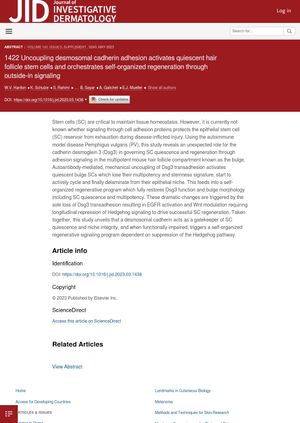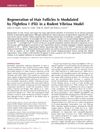Uncoupling Desmosomal Cadherin Adhesion Activates Quiescent Hair Follicle Stem Cells and Orchestrates Self-Organized Regeneration Through Outside-In Signaling
April 2023
in “
Journal of Investigative Dermatology
”

TLDR Disrupting a specific protein's function in hair follicle stem cells triggers their activation and a self-healing process.
The study reveals that the cadherin desmoglein 3 (Dsg3), a cell adhesion protein, plays a crucial role in maintaining the quiescence and regeneration of stem cells in the bulge, a multipotent compartment of the mouse hair follicle. In the context of the autoimmune disease Pemphigus vulgaris (PV), the study found that when Dsg3's adhesion is mechanically uncoupled, quiescent bulge stem cells are activated, lose their multipotency and stemness, and start to actively cycle, eventually delaminating from their epithelial niche. This triggers a self-organized regenerative program that fully restores Dsg3 function and bulge morphology, including stem cell quiescence and multipotency. This regeneration is driven by EGFR activation and Wnt modulation, requiring the suppression of Hedgehog signaling. Thus, Dsg3 acts as a gatekeeper of stem cell quiescence and niche integrity, and its functional impairment triggers a self-organized regenerative signaling program dependent on the suppression of the Hedgehog pathway.
